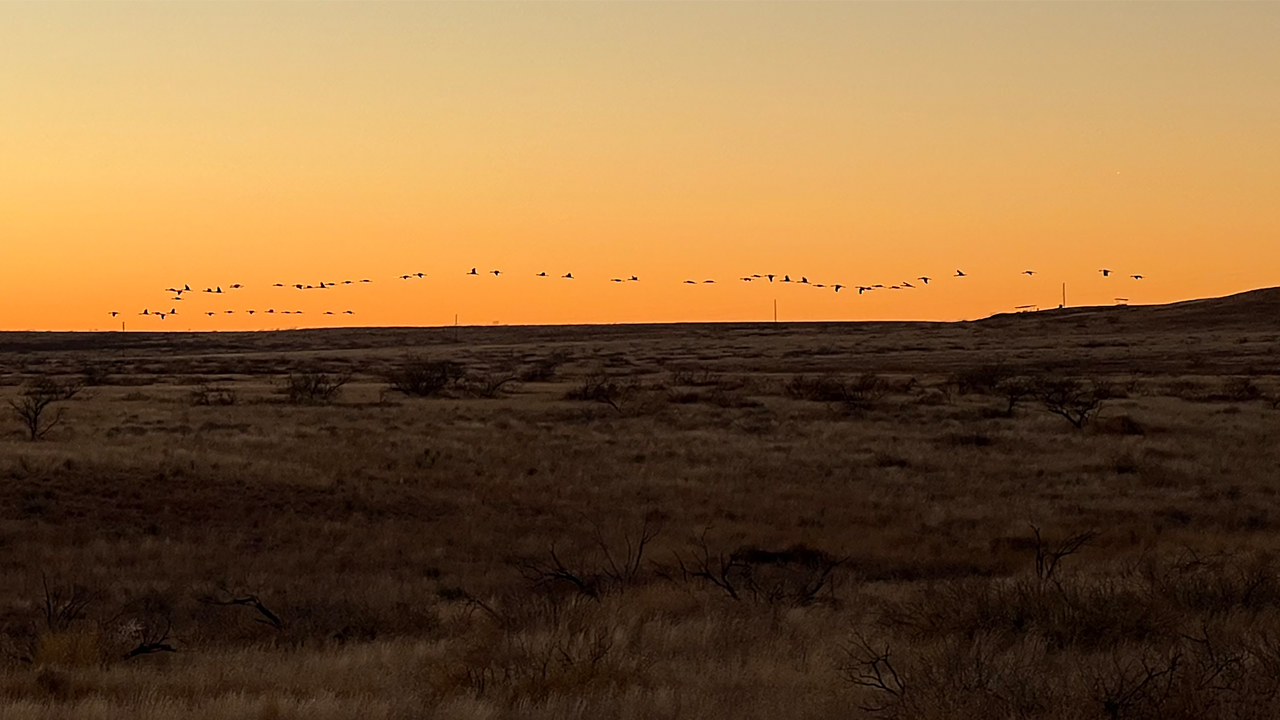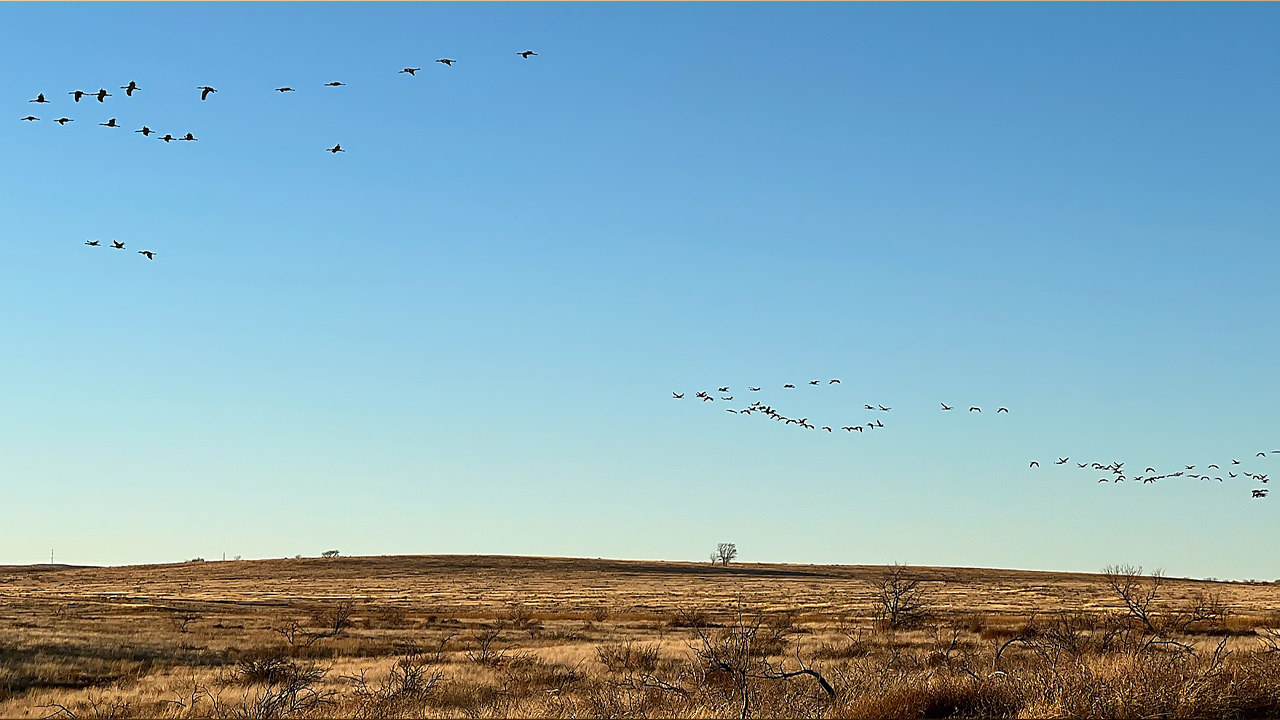Sandhill Cranes come into Muleshoe National Wildlife Refuge for the evening in 2021.
In late June, Facebook posts claimed the Muleshoe National Wildlife Refuge would expand from almost 6,500 acres to 7 million. That’s an area bigger than eight different U.S. states.
It’s not true.
There is a plan to potentially add land.
Jude Smith, the refuge manager for Muleshoe National Wildlife Refuge (NWR), spent 10 years working on a plan to add acres from people who want to sell or donate land toward conservation efforts.
Then the Internet happened. An Austin-based advocacy group took issue with the plan – calling it a land grab and an overreach by the Biden Administration – and from there the issue picked up stream on Facebook.
“It really exploded. I had a lot of people calling me. I think some people kind of may have blown it out of proportion and said we were going to take land,” Smith said.
Those interested in conservation can help Muleshoe NWR. For everyone else, it’s business as usual.
How this started
“I came in here in 2009 and about two years after I was here, we had an offer to buy some property,” Smith said.
Smith went to his boss who gave him permission to explore the idea. But the federal government said no – with a reason.
“We can’t take it. … We’ve got to get an expansion boundary before we can purchase the property,” Smith quoted another official as saying.
Even if the seller was willing to wait, Smith had to say no. If someone wanted to donate land, the answer was no.
Other refuges had expansion boundaries but not Muleshoe. Smith went to work.
In June 2023, the “land protection plan” was approved.
Here’s the plan
Smith drew a map covering parts of Texas and New Mexico. Conservation officials in both states asked him to draw the map bigger. He did. The highest priority is land near Muleshoe NWR southeast of its namesake and Grulla NWR, a few miles west of Muleshoe.
Non-priority areas go all the way west of the Melrose Bombing Range west of Clovis to portions of Lubbock County. They also extend nearly as far southeast as Lamesa.
“This isn’t going to be a forced sale or any kind of eminent domain. It’s all going to be willing sellers or donations,” Smith said.
And just because someone offers to sell or donate, that does not mean he’ll agree. The idea is to create protected spaces for grassland species. Some properties just don’t work for that.
While the refuge can purchase land, it can also purchase an easement – a restriction on certain things.
“For example, no building on it, no structures – that includes turbines or solar farms, hotels, even houses,” Smith said.
Easements can be negotiated. Maybe someone wants to keep the right to set up fencing for cattle. Maybe someone wants to keep the right to drill water wells.
Depending on the negotiations, Smith said an easement might be 60 percent of the total value of the property.
“We’d send them a one-time payment for what they agreed and then that land is in an easement perpetually,” Smith said. That means the conservation measures to help grassland species stay in place forever.

Who pays
There are two federal funds paying for this – the Migratory Bird Fund and the Land and Water Conservation Fund (LWCF). They’ve been around for decades, Smith said.
LWCF money comes from offshore oil and gas leases and is set at $900 million per year. The bird fund comes from Duck Stamps – $29 each – which waterfowl hunters must purchase.
The Fish and Wildlife Service said online, “Federal Duck Stamps [are] among the most successful conservation tools ever created to protect habitat for birds and other wildlife.”
While there are similarities, the rules are different for the two funds.
For example, Smith said, “If it comes through migratory bird funding, I have to open 30 percent of it up to public hunting.”
“There’s only so much money. They will rank them and determine who gets funded in any given year. If your parcel does not get selected for either one of those funds, it goes to next year,” he said,
Realistically, it takes a couple years to get a property purchased.
“Wildlife refuges in particular have to compete for these funds,” Smith said.
Opposition
The plan is more than a year old, but it was mentioned again in April in a statement from the Fish and Wildlife Service. That’s when a few critics came forward such as the Austin-based American Stewards of Liberty.
The federal government seeks to expand the refuge “without Congressional approval,” the group wrote online.
“Removing nearly three-quarter million acres is a direct attack on the oil, gas, and mineral industries, agriculture production, and local economies,” the advocacy group wrote.
LubbockLights.com reached out to American Stewards.
Margaret Byfield, executive director, said, “This is a massive Federal expansion into Texas that is directly tied to the Biden Administration’s 30×30 land grab.”
“After listing two species as endangered in the region they are now providing the solution for landowners to deal with the coming land use restrictions – sell the land to the Federal government or sell a conservation easement forever committing that land to the Refuge,” Byfield said.
Adding a large number of acres to the refuge will permanently erode agriculture, oil and gas and the local economy, she said.
One man, seeing the issue on social media, called Smith. He wanted to know why the refuge was going to go from 70,000 acres to 700,000 and eventually 7 million (which is not true.)
“It just baffled me. … Some people are saying I’m wanting to take away their farms. That’s not how it’s gonna work,” Smith said.
Smith repeated no one will be forced to sell land. No one will be forced to sell an easement to stop oil or gas production. Participation is voluntary.
So far, no land has been sold, but Smith is negotiating a couple of deals.
American Stewards invited people to attend a meeting July 25 at 7 p.m. at the Lamb County Agriculture Building, 1095 East 17th Street in Littlefield.
Conservation benefits
Muleshoe NWR was established in 1935 “ … as a refuge and breeding ground for migratory birds and other wildlife. … ”
The refuge helps antelope (pronghorn), mule deer, Sandhill Cranes, Bob White Quail, Blue Quail, the Lesser Prairie Chicken, toads, and bees, Smith said.
Just the list of birds is 300 species.
“Management is gonna help virtually all short grass prairie animals whether it’s a bird, a mammal or reptile,” Smith said. “We actually do point counts in the spring to come up with densities of these species.”
Sandhill Cranes were doing terrible 80 years ago, Smith said. But now, their population is better.
As one who enjoys hunting, Smith appreciates the benefit of wildlife conservation.
Smith said anyone wishing to sell land or an easement can call him at 806-674-6369 or email him at [email protected].
Comment, react or share on our Facebook post.


 Facebook
Facebook